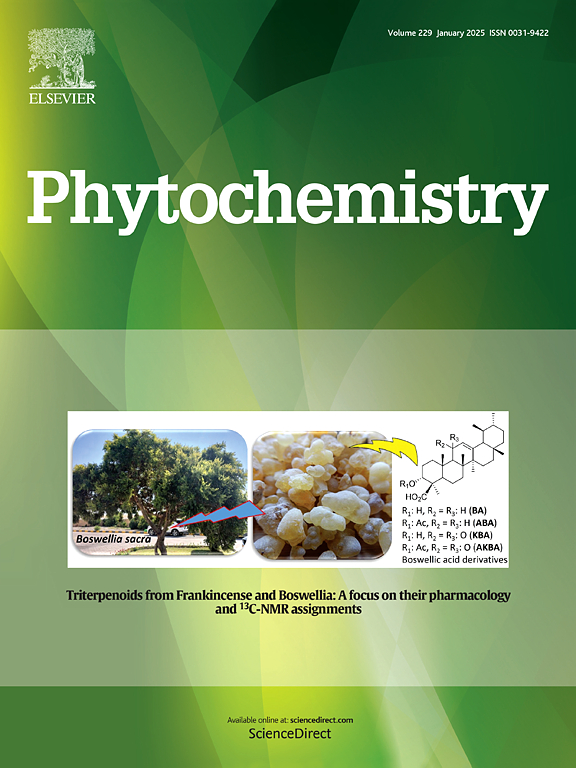酒红木质素重访,直接蛋白,和天然木质素大分子结构。
IF 3.4
2区 生物学
Q2 BIOCHEMISTRY & MOLECULAR BIOLOGY
引用次数: 0
摘要
反义肉桂醇(CAD)下调烟草(Nicotiana tabacum)木质部的酒红色一直被报道是由于酒红色木质素。为了验证酒红色木质素报告的有效性,对野生型(WT)和反义CAD下调的烟草茎木质部组织进行了检测,发现在4°C的MeOH溶液中用0.5% HCl处理可以很容易地去除红色木质素。经过预处理的反义CAD木质部组织和WT木质部组织中,红色素在甲醇溶液中与sinapyl醛孵育后迅速重建,随后用0.5% HCl在甲醇溶液中迅速去除。只有sinapyl醛被证明有助于红色色素沉着,这是一致的阴离子醌的典型形式。没有证据表明存在酒红色木质素。此外,来自反义CAD系和WT系的木质素来源分离物本质上仅存在少量(约1.41%)的8-O-4'连接的sinapyl醛端基,并且来自反义CAD系的木质素分子量分布略小。没有证据表明聚羟基肉桂酰醛有助于散装木质化;稍低的分子量分布(MWD)可能是由于羟基肉桂基醛在木质素化过程中起聚合终止剂的作用。更重要的是,这些发现是在以下方面的背景下进行的:1)植物中木质素大分子组装;2)直接蛋白功能、3D结构和活性位点作为不同植物酚代谢类(包括木质素)的入口点;3)参与木质素的Dir-e亚家族蛋白的AlphaFold2建模;4)木质素研究中迫切需要做的工作。本文章由计算机程序翻译,如有差异,请以英文原文为准。

Wine-red lignin revisited, dirigent proteins, and native lignin macromolecular configuration
The wine-red coloration of xylem in antisense cinnamyl alcohol dehydrogenase (CAD) down-regulated tobacco (Nicotiana tabacum) has long been reported as due to wine-red colored lignin. To investigate validity of the wine-red lignin report, both wild type (WT) and anti-sense CAD down-regulated tobacco stem xylem tissues were examined, with the red pigment found to be facilely removed by treatment with an 0.5 % HCl in MeOH solution at 4 °C. The red pigment in the xylem tissues was rapidly reconstituted in both pre-treated antisense CAD and WT xylem tissues by incubation with sinapyl aldehyde in MeOH solution, and then facilely removed by subsequent 0.5 % HCl in MeOH treatment. Only sinapyl aldehyde was demonstrated as contributing to the red pigmentation, this being consistent with its anionic quinone methide canonical form. No evidence was obtained for a wine-red lignin. Additionally, lignin-derived isolates from both antisense CAD and WT lines essentially differed only in presence of small amounts (ca. 1.41 %) of 8–O–4′ linked sinapyl aldehyde end groups and a slightly smaller molecular weight distribution (MWD) of the lignin from the antisense CAD line. No evidence was obtained that poly-hydroxycinnamyl aldehydes contributed to bulk lignification; the slightly lower MWD may result from hydroxycinnamyl aldehydes functioning as terminators of polymerization during lignification. More importantly, these findings are placed in context of what is now known about 1) lignin macromolecular assembly proper in planta, 2) dirigent protein functions, 3D structures, and active sites as entry points to distinct plant phenol metabolic classes, including lignins, 3) AlphaFold2 modeling of Dir-e subfamily proteins involved in lignification, and 4) what urgently remains to be done in the study of lignification.
求助全文
通过发布文献求助,成功后即可免费获取论文全文。
去求助
来源期刊

Phytochemistry
生物-植物科学
CiteScore
6.40
自引率
7.90%
发文量
443
审稿时长
39 days
期刊介绍:
Phytochemistry is a leading international journal publishing studies of plant chemistry, biochemistry, molecular biology and genetics, structure and bioactivities of phytochemicals, including ''-omics'' and bioinformatics/computational biology approaches. Phytochemistry is a primary source for papers dealing with phytochemicals, especially reports concerning their biosynthesis, regulation, and biological properties both in planta and as bioactive principles. Articles are published online as soon as possible as Articles-in-Press and in 12 volumes per year. Occasional topic-focussed special issues are published composed of papers from invited authors.
 求助内容:
求助内容: 应助结果提醒方式:
应助结果提醒方式:


